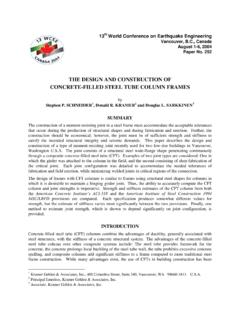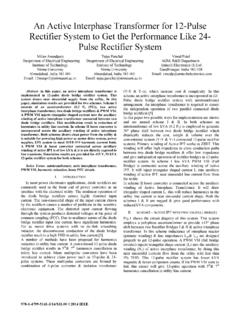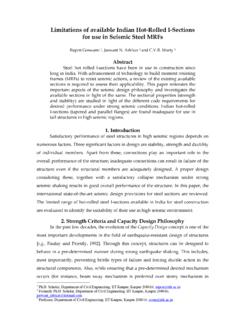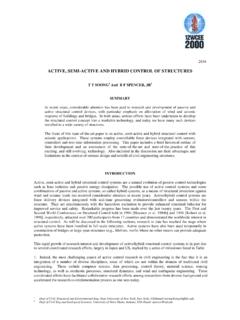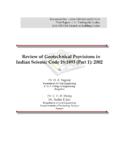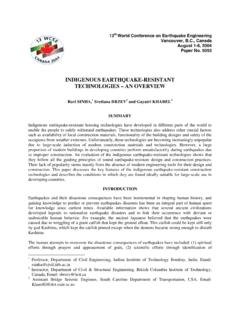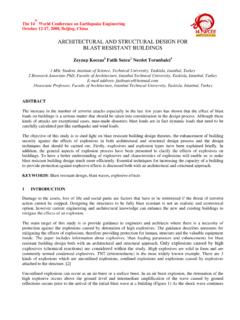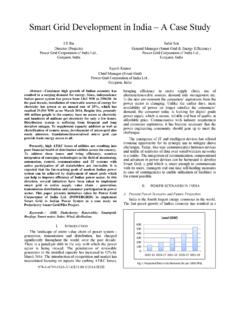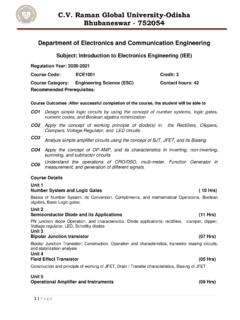Transcription of Inductively Coupled Plasma Mass Spectrometry (ICP-MS)
1 Inductively Coupled Plasma Mass Spectrometry (ICP-MS). Debjani Banerjee Department of Chemical Engineering IIT Kanpur Introduction What is ICP-MS ? Inductively Coupled Plasma Mass Spectrometry Mass Spectrometry (MS) is an analytical technique that ionizes chemical species and sorts the ions based on their mass-to-charge ratio. Inductively Coupled Plasma mass Spectrometry (ICP-MS) is a type of mass Spectrometry which is capable of detecting metals and several non-metals at concentrations as low as parts per billion on non-interfered low-background isotopes. Elemental Analysis with Wide Elemental Coverage Extremely Low Detection Limits (ppt/ppm) or (ng/L to mg/L).
2 Fast Analysis times (all elements at once) Simple Spectra High Throughput & Productivity Isotopic Information Approximate detection capability of ICP-MS. Principle of Atomic Spectroscopy Atomic Absorption Spectroscopy (FAAS). ICP-Mass Spectroscopy Graphite Furnace AAS. (GFAAS). Inductively Coupled Plasma - Optical Emission Spectroscopy Nucleus Electron Atomic Spectrometry Atomic Absorption - Light of specific characteristic wavelength is absorbed thereby promoting an electron to a Light of specific higher energy level. wavelength from Hollow Light absorption is proportional to elemental Cathode Lamp (HCL) - concentration Atomic Emission High energy (light and heat) promotes an - electron to a higher energy level Light and heat energy (excitation).
3 Electron falls back and emits from high intensity source light at characteristic wavelength (flame or Plasma ) - - Light emission is proportional to elemental concentration Mass Spectrometry - High energy (light and heat) ejects electron Light and heat energy from shell (ionization). Result is free from high intensity electron and atom with positive charge (Ion). source ( Plasma ) Ions are extracted and measured directly in mass spectrometer - An atom can only absorb the radiations that it is able to emit Types of Atomic Spectroscopy Air/acetylene flame or an electrically heated Graphite tube is used to evaporate the solvent and dissociate the sample into its component atoms.
4 When light from a hollow cathode lamp passes through the cloud of atoms, the atoms of interest absorb the light from the lamp. This is measured by a detector, and used to calculate the concentration of that element in the original sample ICP-AES is a multi-element analysis technique that uses an Inductively Coupled Plasma source to dissociate the sample into its constituent atoms or ions, exciting them to a level where they emit light of a characteristic wavelength. A detector measures the intensity of the emitted light, and calculates the concentration of that particular element in the sample Crucial steps in atomic spectroscopies and other methods ICP-MS and AAS and AES, X-ray other MS methods methods FAAS, AES GFAAS.
5 Basic Instrumental Components of ICP-MS. Interface: Links the atmospheric pressure ICP ion source to the high vacuum MS. Vacuum System: Provides high vacuum for Ion Optics, Quadrupole and Detector Data Handling & System Controller: Controls all aspects of instrument control and data handling to obtain final concentration results ICP-MS Sample Introduction Area Generation of Positively Charged Ions in Plasma Peristaltic Pump: Ensures constant flow of liquid irrespective of differences in viscosity between samples, standards and blanks. Sample pumped at 1ml/min Micromist Nebulizer: Liquid is converted into a fine aerosol by pneumatic action of a flow of argon gas (~1L/min).
6 Smashing the liquid into tiny droplets Double Pass Spray Chamber: Spray Chamber only allows small droplets (<10 m) to enter the Plasma . Larger droplets having higher momentum collide with wall of spray chamber, get condensed & eventually fall out by gravity through the drain ICP Plasma Ionization Source Inductively Coupled plasmas are formed by coupling energy produced by a RF generator to the Plasma support gas with an electromagnetic field. The field is produced by applying an RF. power (typically 700-1500 W) to a load coil. PHZ: Sample desolvation IRZ: Atomization NAZ: Ionization Degree of Ionization, First & Second Ionization potentials of selected elements Argon first ionization potential ~ 15 eV.
7 Most elements have first ionization potentials below 10 eV, hence >50% ionization Very few elements have second ionization potential below 10 eV, less doubly charged species ICP Interface Region A section that connects the ionizing section at ambient pressure to the mass spectrometer at high vacuum(~10-6 torr). Function is to export the ions produced in argon Plasma and transport them to the mass spectrometer Two metallic (Ni or Pt) cones with small orifices(1mm)- Sampler and Skimmer Cones directs the expanded gas jet of ions into the MS. ICP Ion Focussing Region One or more electrostatically controlled lens component made up of series of metallic plates or cylinders having a voltage placed on them Ions are separated from Photons & Neutrals by positioning MS off-axis to the ion beam or using a Physical barrier Out of a million ions generated in the Plasma , only one actually reaches the detector due to higher concentration of matrix elements than analyte.
8 Role of ion focussing is to transport maximum number of analyte ions from the hostile environment of Plasma to the MS via the interface. Photons & Neutrals cause signal instability & contribute to background noise. Voltages on the ions lens components electrostatically steer the ions of interest into the MS. Mass Analyzer- Quadrupole Quadrupole is a sequential mass filter, Made of stainless steel or molybdenum which separates ions based on their with ceramic coating, 15-25 cm in length, m/z. 1cm in diameter Measurement of the m/z of the ion allows qualitative identification of the isotope or molecule. Magnitude of the ion current is used to provide quantitation of the amount of the analyte in the original sample.
9 Two pairs of parallel cylindrical rods to which a varying AC voltage plus a DC. voltage is applied. Any ion above or below the set mass of the quadrupole enters an unstable trajectory and gets lost from the ion beam. Varying the AC and DC voltages, different masses can be selectively allowed to pass through. Ion Detectors Detector in ICPMS ensures high sensitivity and low background noise. Detector is an Electron Multiplier Device which can generate a measurable signal pulse from the impact of a single ion. A positive ion arrives at the mouth of the detector, it is deflected onto the first dynode, held at a high negative voltage.
10 The impact of the ion releases several free electrons from the dynode surface, which are repelled from the high negative voltage at the front and strike the next dynode. Each electron which strikes a dynode releases several electrons from that surface and hence the device is called "electron multiplier". The multiplication factor builds up a pulse large enough to be measured reliably as an ion "count". Spectral Interferences Introduction: Polyatomic or molecular Spectral Interferences severely compromise detection capability of certain elements by ICP-MS using the Quadrupole mass analyzer technology. Generated by combination of Plasma /nebulizer Gas, solvent and matrix derived ions.

